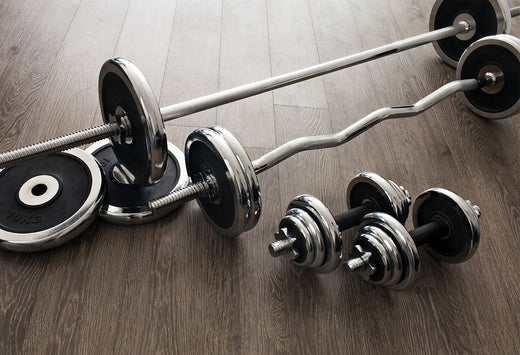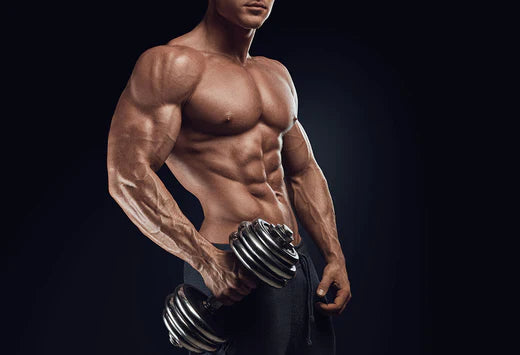Haltères ou barres : lequel est le meilleur pour atteindre ses objectifs de remise en forme ?

Confrontation d'haltérophilie :
Vous entrez dans la salle de musculation. Vous regardez à gauche et vous voyez plusieurs barres et leurs disques. À droite, vous voyez une rangée d'haltères, pesant de 2,3 à 56 kg. Vers quel côté commencez-vous à marcher ?
Les haltères et les barres à disques sont des équipements de fitness fondamentaux. Il est indéniable qu'ils sont tous deux importants pour un programme de remise en forme complet. Mais imaginons que vous deviez en choisir un seul pour le restant de vos jours. Lequel choisiriez-vous ?
Si vous êtes comme la plupart des gens, il est difficile de prendre position. Nous souhaitons nous amuser un peu et trancher définitivement. Examinons les avantages et les inconvénients des haltères et des barres d'haltères afin de déterminer lequel est le plus adapté à vos objectifs fitness.
QU'EST-CE QU'UN HALTÈRE ?
C'est plus qu'un surnom pour votre meilleur ami.
L' haltère est un outil de fitness utilisé pour la musculation. Il s'agit d'une barre courte et lestée, ou d'une poignée, offrant suffisamment d'espace pour la saisir. À chaque extrémité de la barre se trouve un poids. Selon le type d'haltère, le poids sera fixe ou réglable. Si vous possédez un haltère réglable, vous remarquerez qu'un élément surélevé, juste à l'extérieur de votre main, empêche les disques de bouger. De chaque côté de la poignée, vous pouvez placer un ou plusieurs disques, puis les fixer avec une vis.
LES AVANTAGES DES HALTÈRES
Qu'est-ce qui rend les haltères si spéciaux pour qu'ils existent depuis des décennies ?
Doux pour les articulations
Les haltères sont parfaits pour les personnes ayant subi des interventions chirurgicales ou des blessures antérieures. Grâce à leurs mouvements plus naturels et à leur amplitude complète, ils ménagent vos articulations pendant l'exercice.
Empêche la surcompensation
Lorsqu'un muscle fort prend le relais d'un muscle faible voisin, on parle de surcompensation. À terme, cela peut épuiser le muscle fort et augmenter le risque de blessure. Les haltères vous obligent à vous entraîner de manière unilatérale, ce qui signifie que chaque côté du corps doit travailler. Un côté plus fort, comme le côté droit par exemple, ne peut pas compenser le surplus de tension. Même si cela implique d'utiliser un poids plus léger, cela signifie également que vous développerez force et masse musculaire de manière égale.
Activation musculaire
Des études montrent que les haltères augmentent davantage l'activation musculaire que les barres lors de certains exercices. Par exemple, les haltères sollicitent davantage le biceps brachial lors d'un développé couché qu'une barre. [1]
Commodité et coût
Les haltères sont l'un des équipements d'haltérophilie les plus pratiques du marché. Hormis la restriction évidente des poids plus lourds, vous pouvez emporter vos haltères pour vous entraîner en extérieur, dans un parc ou en voyage.
Ils sont également parfaits pour aménager une salle de sport à domicile. Un simple jeu d'haltères de 2,3 à 11 kg suffira à la plupart des gens et vous permettra d'économiser beaucoup d'argent sur les abonnements coûteux en salle de sport.
Sécurité globale
En général, les haltères constituent une option plus sûre.
Cela permet d'ajuster le poids plus facilement et, si les objets deviennent trop lourds, de les jeter sur le côté. Si vous avez un partenaire d'entraînement, il constatera que les haltères sont généralement plus faciles à repérer qu'une barre.
QU'EST-CE QU'UNE BARRE ?
On peut comparer une barre à un haltère surdimensionné. Une longue barre d'acier moletée offre différents points de prise. Comme pour un haltère réglable, vous pouvez ajouter ou retirer des disques de poids selon vos capacités, votre exercice et vos préférences. Ces disques sont maintenus en place par un clip ou une attache. Une barre d'haltérophilie diffère d'une barre olympique. La première peut varier en taille, en poids et en types de disques externes. Une barre olympique, en revanche, est toujours de taille et de poids réglables. Elle mesure 2,13 m de long et pèse 20 kg. C'est le type de barre que l'on trouve dans la plupart des salles de sport. Contrairement aux haltères qui peuvent être posés ou empilés au sol, une barre nécessite un support pour un rangement optimal et une bonne performance. Un support à squat est idéal pour les débutants afin de ranger sa barre et d'effectuer divers exercices de base comme le squat et le développé couché.
AVANTAGES DES BARBELLES
Voici quelques raisons pour lesquelles une barre serait un excellent choix pendant vos entraînements.
Poids maximal
Pour ce qui est du poids maximal, les haltères sont ce qu'il vous faut. Les haltères olympiques ont une limite de poids de 225 kg. Bien sûr, vous n'en prendrez peut-être qu'un peu, mais c'est rassurant de savoir que c'est possible.
Définition de nouveaux 1RM
Poursuivant sur le point précédent, compte tenu de la limite de poids élevée d'une barre, celle-ci constitue un outil fantastique pour établir de nouveaux records personnels par répétition. Cela est d'autant plus vrai pour ceux qui s'intéressent à la dynamophilie ou au strongman. La dynamophilie se concentre sur trois exercices : le squat, le soulevé de terre et le développé couché. De plus, l'objectif est d'établir un nouveau record personnel chaque semaine. La barre est idéale pour ce type d'athlète.
Explosivité
Le levage explosif est indispensable pour améliorer sa puissance brute, son accélération et sa vitesse. Les barres olympiques sont spécialement conçues pour ce type de levage ; il n'est donc pas surprenant que les sports de puissance comme le CrossFit en fassent autant appel. Voici un aperçu :
Lorsqu'on regarde une barre, on voit deux pièces distinctes : le manche et la barre. Les barres sont conçues pour que leur extrémité puisse tourner lors de mouvements comme l'épaulé-jeté ou l'arraché.
LES HALTÈRES SONT-ILS MEILLEURS QUE LES BARRES ?
La réponse courte est : cela dépend.
Vous débutez dans le fitness ? Vous vous remettez d'une opération ? Vous souhaitez acquérir les bases de votre forme physique ? Alors, les haltères sont faits pour vous.
Vous pratiquez la musculation depuis longtemps ? Êtes-vous un powerlifter ? Vous souhaitez développer votre puissance et votre force brutes ? Vous préférez peut-être les haltères.
Ceci étant dit, voyons pourquoi les haltères sont meilleurs que les barres. Notre constat est basé sur le fait que de plus en plus de personnes débutent en fitness ou manquent de confiance en leurs entraînements.
Ils sont plus pratiques
Malgré leur poids et leur durabilité, les haltères manquent de praticité. Si vous utilisez une barre, vous êtes limité à cet endroit. À moins que vous ne vouliez essayer de faire rentrer un haltère de 20 kg dans une voiture à chaque déplacement.
Les haltères, en revanche, peuvent être transportés d'un lieu d'entraînement à l'autre dans la mesure du raisonnable. Voyager avec des haltères de 70 kg, par exemple, sera difficile, mais il y a de fortes chances que vous ne le fassiez pas de toute façon.
La surcompensation n'est pas un problème
Étant donné que vous vous entraînez de manière unilatérale (un côté à la fois), vous n'avez pas à vous soucier du fait qu'une partie du corps prenne le relais d'une partie plus faible.
Avec les haltères, ce n’est pas le cas.
Si votre côté droit est sensiblement plus faible que votre gauche, ce dernier devra supporter plus d'efforts et de poids. C'est particulièrement vrai si votre posture est également incorrecte.
La meilleure façon de construire une base en forme
Pour reprendre l'idée précédente, les haltères sont le meilleur moyen de commencer à apprendre à soulever des poids. Il n'y a pas de place pour la surcompensation ; vous pouvez ajuster rapidement vos poids et ils sont faciles à utiliser.
De plus, les haltères peuvent être plus confortables pour les nouveaux utilisateurs pendant que le corps renforce ses connexions neuromusculaires.
Le risque de blessure est faible
Bien sûr, les haltères ne sont pas sans risque, mais vous pouvez les lancer loin de vous, avec ou sans observateur. Vous n'avez pas à craindre qu'une barre ne vous tombe dessus.
De plus, nous avons remarqué que de nombreuses personnes dans les salles de sport sont plus susceptibles de sélectionner le bon haltère que le poids approprié pour une barre.
Cela pourrait être lié à l'ego, mais d'après mon expérience, une fois que la plaque de 45 livres est sur la barre, elle ne se détache pas avant la fin… même si la personne a du mal avec.
HALTÈRES VS BARRES :
IL Y A UN TEMPS ET UN LIEU POUR LES DEUX
Nous pensons qu'il y a un temps et une place pour les haltères et les barres. Haltères et barres doivent être utilisées ensemble dans un programme de fitness, car les points forts des uns compensent les faiblesses des autres. Et si vous n'avez accès qu'à une barre – c'est votre seul outil de fitness –, alors n'hésitez pas à l'utiliser ! Mais dès que vous en avez la possibilité, pensez à ajouter des haltères à votre collection.
Références
- Saeterbakken AH, van den Tillaar R, Fimland MS. Comparaison de l'activité musculaire et de la force 1-RM de trois exercices de développé couché avec différentes exigences de stabilité. J Sports Sci. 2011 mars ;29(5):533-8. doi : 10.1080/02640414.2010.543916. PMID : 21225489.


